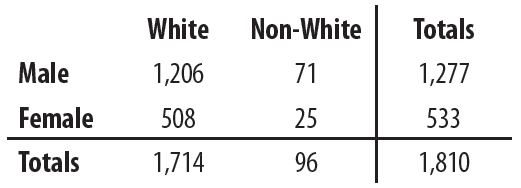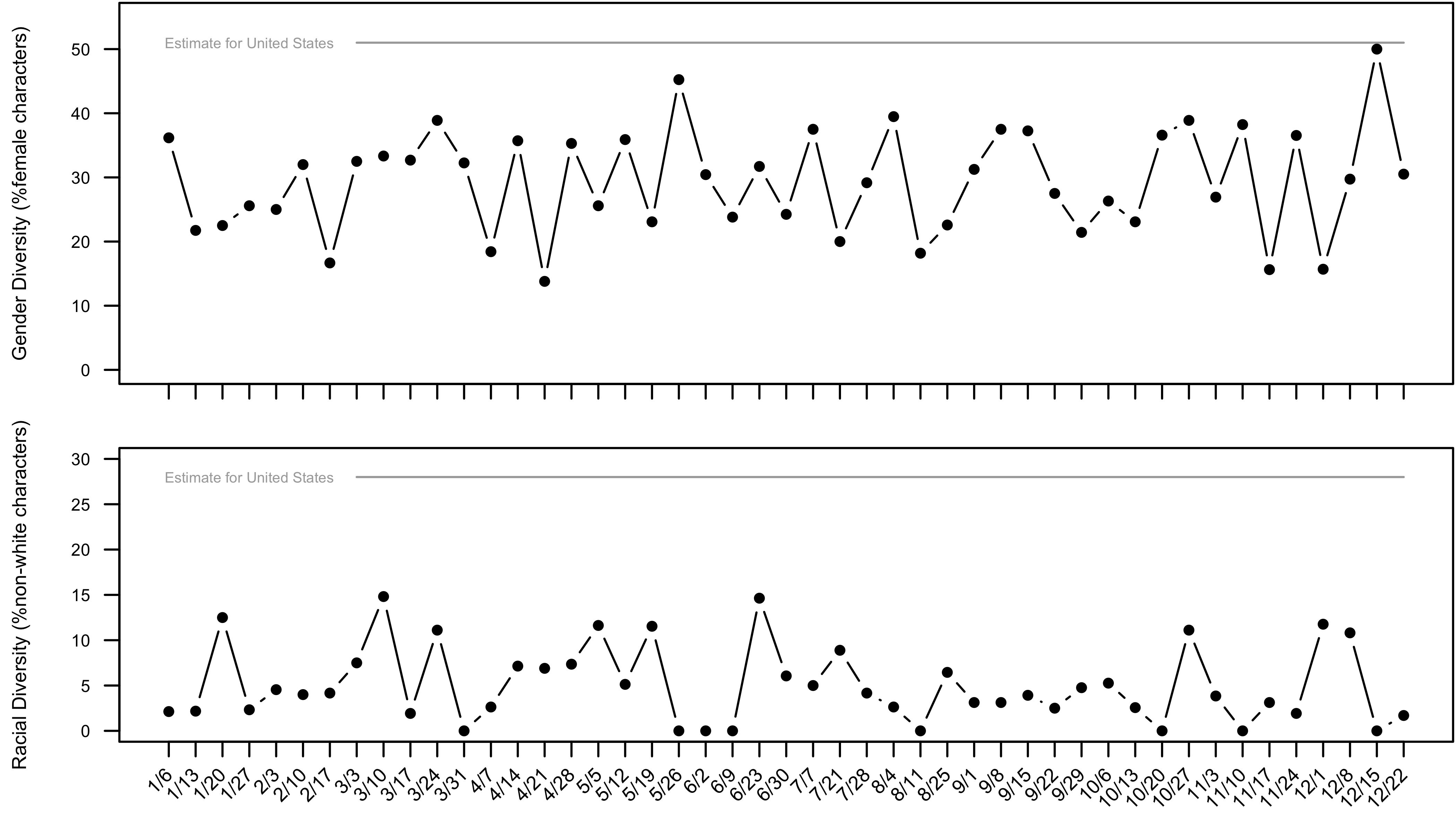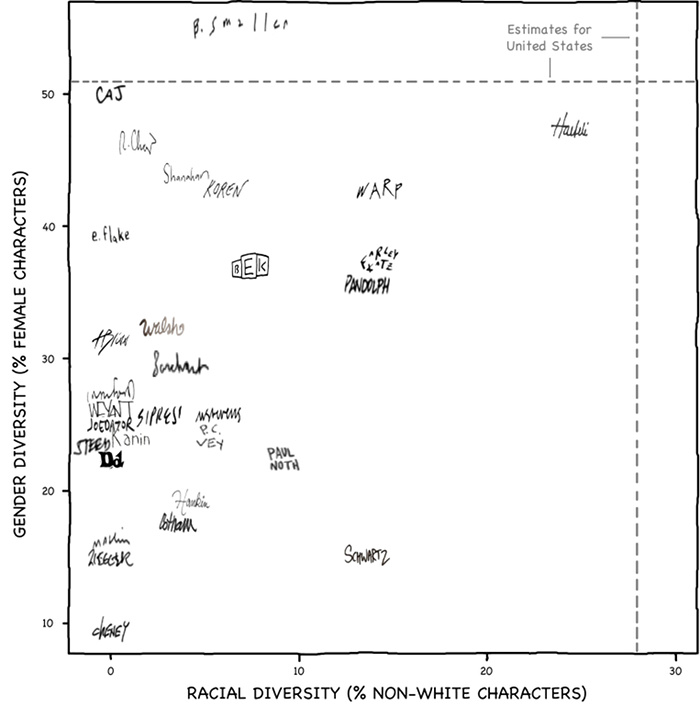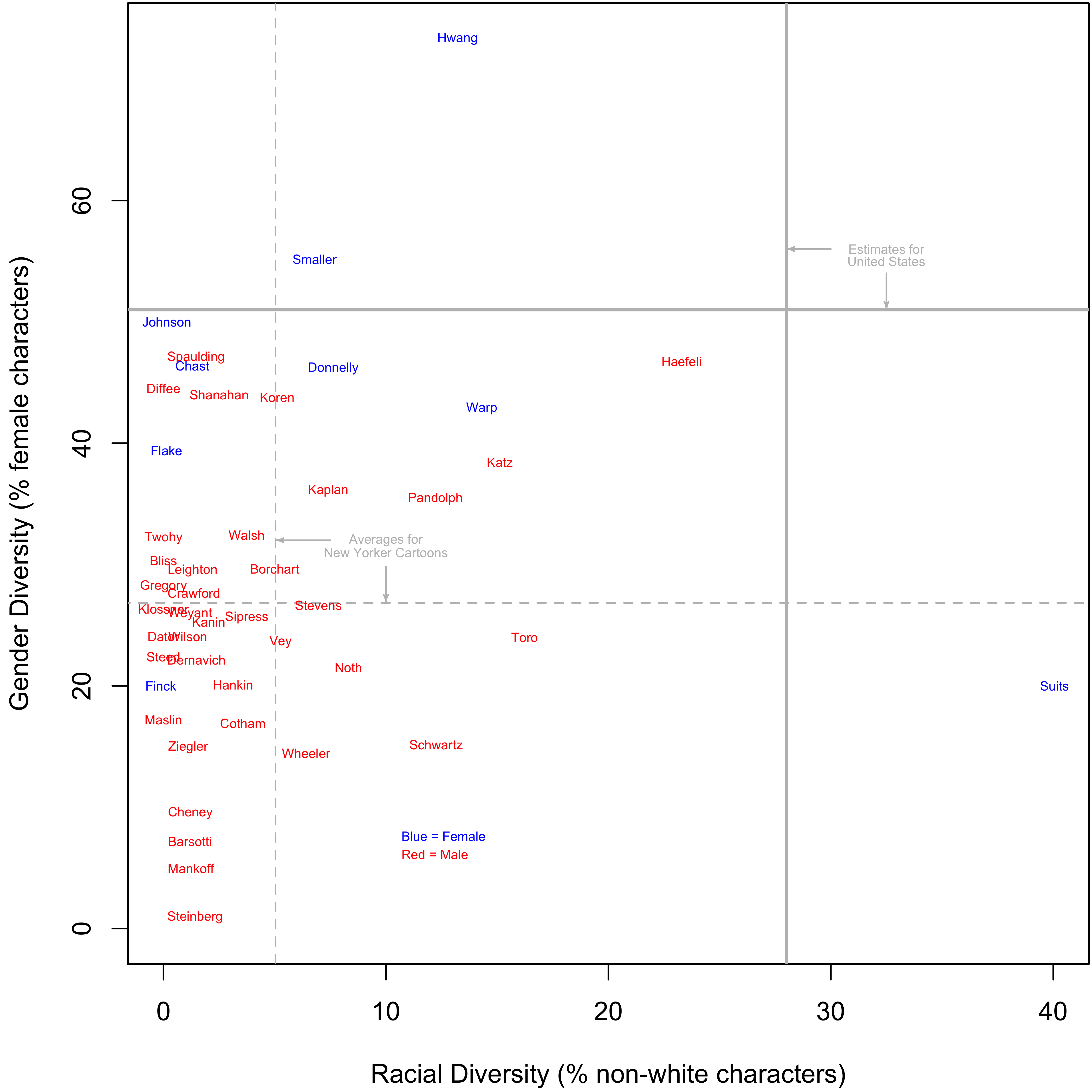
Tweet
May 7, 2015
Proceedings of the Natural Institute of Science | Volume 2 | HARD 6
Racial and gender diversity of the characters in The New Yorker cartoons
Matt J. Michel1
1 - PNIS

Introduction
In October 2013, Saturday Night Live found itself in the middle of a diversity scandal. They hadn’t hired a black female cast member in over 5 years, and current male cast members were beginning to protest against playing female characters. Blogs were written. Infographics were made. Three months later, SNL hired Sasheer Zamata, a black comedian.
In January 2015, the Academy Awards jumped into the same diversity controversy vacated by SNL. Of the 20 nominated actors/actresses, precisely 0% of them were black (let alone any minority). More blogs were written. More infographics were made. Hashtags were concocted. The Academy responded by increasing the diversity of its award presenters, and, oh look, emcee Neil Patrick Harris is engaging with black actors!
That American media and pop culture tend to skew towards white males is well-known. Evidence of this bias has been documented in everything from cereal boxes and the Saturday Morning Cartoons to films & television shows and newspapers. In fact, this bias is so prevalent that one might formulate a Law of Media, in which underrepresentation of minorities and females is the default setting for any given media outlet.
Could we find a media outlet that would actually break this Law? That is, is there a media outlet in which we would not expect an underrepresentation of females and non-whites? We can hypothesize that such a media outlet would have the following qualities: it should be left-leaning (since liberals are more racially diverse and have a more positive view towards females than conservatives) and it should be based in a racially diverse city (since exposure to different ethnicities decreases implicit biases).
Well, the media outlet with the most liberal audience happens to be The New Yorker magazine, and after some diligent research, The New Yorker happens to be published in New York, which just happens to be the 3rd most diverse city in the United States. We also just happen to have a subscription to The New Yorker.
We could analyze the representation of different ethnicities and genders in the articles of The New Yorker. However, The New Yorker is probably just as well known for its cartoons. And since we are a publication whose bread and butter is statistical analyses of cartoons (see here and here), that will be the focus of our research: do the characters of The New Yorker cartoons skew towards white men?
Methods
Our subscription to The New Yorker started in 2014, so we analyzed the gender and race of the cartoon characters in all 47 issues of 2014 (sometimes The New Yorker publishes one issue that covers two weeks). Issues that were not available from the magazine rack in my bathroom were obtained through The New Yorker’s online archive.
For each cartoon we recorded the race (“white” or “non-white”), gender (“male” or “female”), occupation (as best we could) and if the character was talking. The name of the cartoonist was also recorded. Only cartoons with humans were included. We focus exclusively on gender and racial statistics here and will discuss the other recorded data in a future article.
While gender was easy to discern for most characters (excluding babies), race was not as simple. We settled on a simple rule of recording every character that had some sort of shading (that was not due to a shadow) as a non-white character. If in doubt of a character’s race (which was rare), we recorded them as non-white (so our estimates are likely overestimates).
Results and Discussion
Overall diversity – In the 47 issues we examined, we recorded 1,810 characters in 639 cartoons by 70 cartoonists. 94.7% of these characters were judged to be white (thus 5.3% were non-white), and 70.6% were judged to be male (29.4% female) (Table 1). For reference, about 72% of the US population is estimated to be white (this categorization includes Hispanics) and about 51% is estimated to be female.

How do the The New Yorker cartoons compare to other types of media? Non-whites (excluding Hispanics) make up anywhere from 2 - 4% of characters in newspaper comics, about 5 - 10% of characters in animated cartoons (like Bugs Bunny and Yogi Bear), 9% of characters in children’s books, and about 11% of characters in DC superhero comics. Thus, you are more likely to encounter a racial minority while watching the Saturday Morning Cartoons or reading a DC comic than while browsing The New Yorker cartoons.
Diversity Trends from January to December – From our understanding, cartoons at The New Yorker are drawn and picked on an issue-by-issue basis. Thus cartoonists have the opportunity to respond to current events. So we were interested if racial and gender diversity of cartoon characters responded to important events of the past year (specifically the protests in Ferguson, Missouri). We plot % non-white and % female for each issue in Figure 1.

First, there doesn’t seem to be any long-term trends for either gender or racial representation. Both seem to just fluctuate around their respective means (again, 29.4% female and 5.3% non-white).
The unrest in Ferguson occurred from August 9 to August 25, and racial diversity in The New Yorker was below the mean in the August 11th issue and above the mean in the August 25th issue. A second wave in Ferguson erupted after the no-indictment verdict of Darren Wilson on November 24th. This did seem to correspond with a moderate spike in % non-white characters in the two issues following the verdict (December 1st and December 8th. Also note that the December 8th issue was the St. Louis Arch cover issue.). December 3rd was also the date that a grand jury decided not to indict Daniel Pantaleo over the homicide of Eric Garner.
However, there are spikes that do not seem to correspond with an important racial event, like the spike on June 23rd (although we are not qualified to designate what is and what isn’t an important racial event).
Gender and Racial Representation by Cartoonist – We can also separate % female and % non-white by the different cartoonists. The range for % female for all 70 cartoonists ranged from 0% female (11 different cartoonists) to 73.3% female (cartoonist: Amy Hwang), and the range for % non-white ranged from 0% non-white (40 cartoonists) to 40% non-white (Julia Suits).
Some of these statistics are based on very low sample sizes. For example some cartoonists only published one or two cartoons in 2014. We narrowed down the dataset to the 30 cartoonists with the most characters drawn in 2014 and present the results in a cartoony figure (Fig. 2). We also made another less cartoony figure (Fig. 3) with the top 46 cartoonists (basically any cartoonist that drew at least 10 people).


From these figures, we see that very few cartoonists meet or exceed the actual gender and/or non-white diversity of the United States. Only one cartoonist (Julia Suits) exceeds the 28% non-white US estimate (although William Haefeli comes close). Two cartoonists exceed the 51% female US estimate (Amy Hwang and Barbara Smaller) and one cartoonist comes in at 50% (Carolita Johnson). These three are all women, by the way.
[In an upcoming article, we will examine if % female or % non-white characters is related to the gender and ethnicity of the cartoonist.]
Some caveats – The data presented here is just a sample. It does not state, for example, that some cartoonists have never ever drawn a non-white character. For example, cartoonist Tom Cheney, while having never drawn a non-white character in a cartoon published by The New Yorker in 2014, has indeed drawn non-white characters before. Furthermore, cartoonists submit hundreds if not thousands of cartoons for publication in The New Yorker (in fact, they published a book on the rejected cartoons), so the decisions of the Cartoon Editor (Robert Mankoff) must be remembered in interpreting this data.
We also limited our analysis to just the cartoons in The New Yorker. Most cartoonists do other creative works whose gender and racial diversity were not examined by this article. For example, Roz Chast has published a “Sketchbook” in a March 2014 issue of The New Yorker that contains non-white characters.
Conclusions
It was expected (and hoped!) that The New Yorker, having the most liberal audience and located in the 3rd most racially diverse city in the US, would have broken the Law of Media that we made up in the Introduction (i.e., that underrepresentation of females and minorities should be assumed for any media outlet). Yet The New Yorker, with respect to its cartoons, followed this Law and did no better than Saturday Morning Cartoons or cereal boxes in representing females and minorities.
But does any of this matter? Are there consequences to underrepresenting minorities and females in media? Yes, there are, and here are some links to research and articles that strongly suggest this: Cort 1987, Wood 1994, The Opportunity Agenda 2011, Elliott 2012, Myers 2013, WMC 2014, Rothschild 2015. Briefly stated, the underrepresentation of females and minorities can perpetuate discrimination.
This problem of underrepresentation of minorities and females should be an easy fix. Cartoonists can simply draw more female and minority characters. This would amount to more than just pandering. For example, the study we linked to in the Introduction suggets that even just looking at African American faces can reduce implicit racial biases. For his part, Robert Mankoff can also begin to encourage cartoons featuring more women and minority characters. Certainly, females and minorities can experience humorous non sequitur situations too, right?

Proceedings of the Natural Institute of Science (PNIS) by https://instsci.org/ is licensed under a Creative Commons Attribution-ShareAlike 4.0 International License.